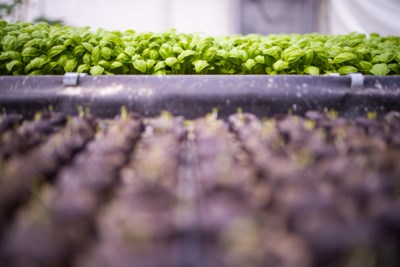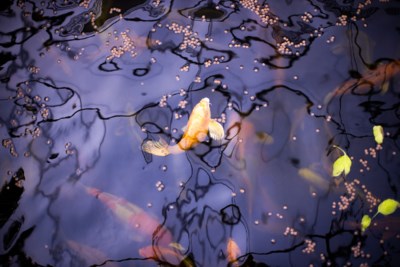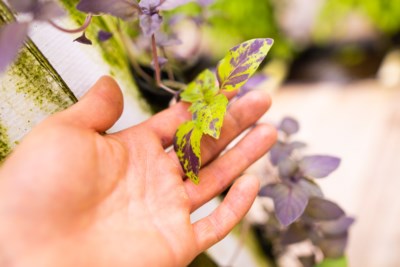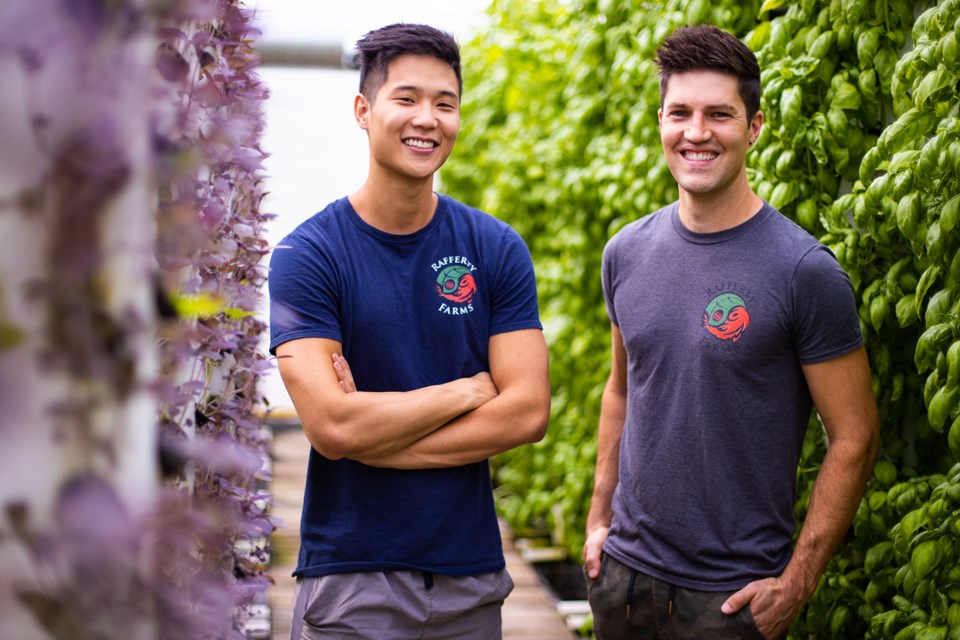With a background in aircraft maintenance and a fondness for house plants, James Rafferty wasn’t the most likely candidate to operate a commercial greenhouse—but that didn’t stop him and his business partners.
Rafferty Farms, located just outside of Okotoks, focuses on reducing impact, growing sustainable crops, and finding new ways to farm—using a relaxing koi pond.
“We can’t keep going—as far as we’re concerned, climate change is real. We can’t keep just dumping fertilizer, spraying everything with pesticides, it just doesn’t make sense,” said Rafferty. “We need to actually make a change, and we wanted to be part of that positive change and push towards a more sustainable growing future.”
Having started an LED lighting business in 2009, Earthis Ltd., Rafferty said he wasn’t seeing a purpose in that field and his heart wasn’t in it anymore.
In 2015, he and his business partners bought their first greenhouse.
Transitioning into the greenhouse industry was a leap of faith for Rafferty and his partners, Brian Hsu, aquaponic systems technician, and Nick Hsu, who handles the business end of the operation.
Brian Hsu said their greenhouse was not a knock on conventional farming as “they have fed us and worked so hard their whole lives,” but was rather a way of finding a more balanced and safe farming method year-round.
Originally intending to use hydroponics—or chemical nutrients—they stumbled across aquaponics online, and found it made more sense for their goals.
After four years of testing new systems in the prototype greenhouse, they finished construction of the 7000 sq. ft. greenhouse earlier this year.
 Basil sprouts are grown in trays before being planted into vertical growing towers. (BRENT CALVER/Western Wheel)
Basil sprouts are grown in trays before being planted into vertical growing towers. (BRENT CALVER/Western Wheel)With a personal background as a pastry chef, Hsu wasn’t any more knowledgeable in growing plants or raising fish than Rafferty was, which made the last four years a crash course.
Describing one of their earlier mistakes, Hsu said they originally kept the prototype greenhouse too warm 24/7, thinking basil likes warm temperatures.
“It was so ridiculous, because it all goes back to nature: at night it cools down and in the day it’s warm, so you need that differential temperature,” he said. “It’s super basic stuff.”
The greenhouse itself stands apart from more traditional aquaponics; instead of using farmed fish, such as tilapia or trout, they have a koi pond.
“Part of the reason we didn’t go with a food fish was for one, and I don’t know if this has changed, but there was no processing facilities in Alberta,” said Rafferty. “And, honestly, we couldn’t bear the thought of murdering our fish.”
Describing themselves as mostly vegetarian, the thought of farming their fish was not an option, and said they have gotten far too attached.
While the prototype greenhouse looks more industrial with fish tanks and exposed plumbing, the new greenhouse with it’s koi pond is a picture-perfect relaxation scene.
Part of their business model is to sell the greenhouse kits, making it important for the greenhouse to offer the landowner a nice place to spend time, said Rafferty.
The pond itself is 16.5 feet wide by 15.5 feet long by 9 feet deep.
“It makes it a little more difficult to work around the pond, having such a large and deep pool, but the fish are our pets,” said Rafferty.
Being fond of their 186-plus koi, Rafferty and Hsu spoke of the individual personalities of the fish, and have named many of them, such as: Monster, Idiot (for his apparent lack of self-preservation instincts when it comes to eating), Tigger, Monocle, Panda, Rex, Spot, Flash, Spot Flash Jr., and so on.
 Koi fish make up a major part of the Rafferty Farms' ecosystem, providing nutrients to the water that is then pumped through suspended vertical growing towers. (BRENT CALVER/Western Wheel)
Koi fish make up a major part of the Rafferty Farms' ecosystem, providing nutrients to the water that is then pumped through suspended vertical growing towers. (BRENT CALVER/Western Wheel)Keeping a balance of the amount of fish needed to support the plant growth, aquaponics uses the waste from the fish as fertilizer for the plants.
Rafferty said they are primarily focused on the ammonia released from the gills, which is dissolved in the water and then circulated to the plants.
From there, the microorganisms in the soil convert the ammonia into nitrate, which the plants then absorb as fertilizer.
The leftover water—now cleaned of the toxic ammonia that is often the culprit of pet fish deaths—then trickles into the gutter system and is reintroduced to the pond in a waterfall.
“There’s tons of biofiltration in the greenhouse,” said Rafferty. “It’s hard to believe, but there’s 60,000-litres of water in this fish tank right now, and this entire volume of water is going out to the greenhouse and coming back every hour.”
The high flow rate results in clear, clean water, said Rafferty, which in turn creates a better quality-of-life for their fish.
“They will live their best lives here,” said Rafferty. “The koi can outlive us, so honestly whoever inherits the greenhouse will probably have a bunch of our original koi.”
The plant growing aspect of the operation is further optimized by their own design, through the use of vertical growing towers rather than growing horizontally.
Having refined the design of their growing towers, the greenhouse is comprised of rows of towers which help maximize the space.
Inside each tower is a growing medium that includes microorganisms and worms that composts the leftover root mass, filters the water that trickles down, and otherwise keeps its own complete ecosystem.
“It’s sort of like what happens in the field, but vertical,” said Rafferty. “… I honestly don’t know the conversion of how much square footage 120,000 basil plants would take up, but it’s definitely more than this (6000 sq. ft.).”
Sustainability is a core value of Rafferty Farms, but tends toward the “as sustainable as reasonable,” with an emphasis on reducing impact.
With the water-shortage affecting the region, Rafferty Farms is doing its part to offer a potential solution: use less water.
“It’s part of the reason we decided to do the aquaponics system in the first place, because then we’re not using a massive amount of water—and traditionally, irrigation uses a ton of water,” said Rafferty.
The water use in the greenhouse is largely a reduce and reuse operation, supported by a rain water catchment system and constant circulation of the tanks—with over 120,000 plants and 1,000-litres (one cubic metre) of water maximum per day.
 One of the crops offered by Rafferty Farms is Thai basil, which thrives in the ecosystem created by the aquaponics system. (BRENT CALVER/Western Wheel)
One of the crops offered by Rafferty Farms is Thai basil, which thrives in the ecosystem created by the aquaponics system. (BRENT CALVER/Western Wheel)Another change made at Rafferty is the lack of chemical nutrients, fertilizer, or pesticides, which Rafferty described as a “low-impact way of growing.”
The lack of pesticides isn’t to say they don’t have pests, they just use nature’s fix: natural predators.
“The main insects that attack our basil are called thrips, and they’re especially populous around here with all the canola fields,” said Hsu.
Thrips are capable of destroying an entire crop if given the opportunity, so Rafferty and Hsu have become familiar with the canola harvest times and release their pest control insects in advance to circumvent the issue entirely.
Everything from the packaging area—which is between the front door and the growing area, and has separate temperature controls—to the air intake system has been designed to slow pests’ ability to access the greenhouse.
“Most greenhouses just open the vents and whatever comes in, comes in,” said Rafferty. “Which is not ideal, when it’s so intensive. When there’s so much vegetation in there, they just have a hay day, so we can’t do that.”
By controlling the pest situation from the get-go, they said they avoid the “panic mode” purchasing of the beneficial insects, which can cost thousands of dollars.
Through their method, they release a roughly Pringles-sized tube of hypoaspis mites every so often—roughly 25,000.
In addition to the mites, which can only walk, they release orius bugs, which can fly from plant to plant.
“The (mites) are the army bugs, and the orius are the air force,” said Rafferty. “Then there’s this nuclear bomb we can throw in there, and they’re soil nematodes basically… but that’s only if the problem is really bad.”
Growing primarily Genovese basil, with the recent additions of Thai basil and spearmint, Rafferty Farms has been supplying basil to Sobeys Okotoks since 2015, calling them their first “proper customer.”
Their produce has been since finding its way to Lethbridge, Canmore, Banff, Edmonton, and more recently Calgary in Blush Lane Organic Markets and Community Natural Foods.
The majority of their buyers are restaurants in the region, who have come to rely on their consistent, year-round, local produce.
“The reason we grow basil is because it doesn’t transport well and our distributor gets things to the restaurants the day after it is ordered,” said Rafferty. “If we find crops that are sort of a niche crop, aren’t readily available or are hard to get elsewhere, that’s sort of the crops we’re going for.”




